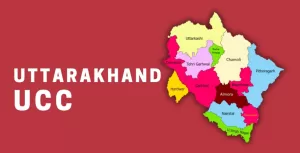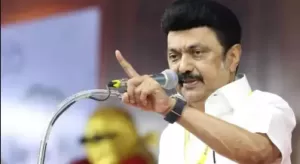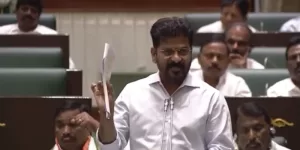[On the occasion of the 93rd birth anniversary today (6 December 2021) of one of the seminal thinkers around dance, we reproduce a lecture titled ‘Changing Phases of Bharatanatyam’, she delivered (along with a demonstration of segments of her path-breaking 1985 choreographic production ‘Angika’) at the morning session of the Annual Festival of the Music Academy, Madras, on January 1, 1986.
In her signature prose-poetry style, Chandralekha outlines a deeply conceptual understanding of her context and signals the need for a radical re-think for new directions in dance. Thirty-five years on, her call for contemporary relevance in dance remains valid.]
❈ ❈ ❈
Once upon a time, dance related to life and to daily functions of life – like food gathering, hunting, fishing, planting, cultivating, harvesting.
Once upon a time, dance was related to stars, to the sun and moon, their cyclic movements, the movement of the Earth; the crescent and the full moon; and the moon on the fifth or seventh or eleventh day – panchami, saptami, ekadashi, paurnami, phalguni, vaishakhi.
And to the movement of constellations – swati, chitra, hasta, revati.
And to the eclipses – rahu, ketu; and to the seasons – vasant, sharad, shishir; and to the feelings of rain and heat and the cold nip in the air.
Once upon a time, dance related to Prithvi; to directions and to the guardians of directions – varuna, yama, kubera; and to mountains and rivers.
And to wind and water and clouds – chandavayu, parjanya; to navagraha and pancha bhuta; to agni and akasha; to purusha and prakriti – the male and female principles.
Once upon a time, dance related to trees and forests and groves and pastures, to their silences and sounds; and movement of trees and flowers – kamal and ketaki; mandara, parijaata, champaka, kadamba – tree flowers, water flowers, grass flowers, creeper flowers.
Once upon a time, dance related to birds and animals; and bees and butterflies – bhramara, prajapati; horse and tiger and boar; and monkey and lion and elephant; the majesty and dignity of their bodies, their walk, their mass and lightness and weight and gravity.
Once upon a time, dance related to the daily chores of life – sweeping and cleaning; grinding and pounding; sprinkling and cow-dung paving; planting and transplanting.
Once upon a time, dance related to Space – space intimate and space infinite; and to Time – time immediate and time eternal; and to the movement of prana – breath inhaled and breath exhaled; inner and outer.
Once upon a time, dance related to fertility of soil and of people; to bodies of men and women; to the poetry and power in their bodies.
Once upon a time, dance was an expression of the collective, the community; of togetherness; of generation of energy, of ananda; of linked hands of men and women, young and old.
Once upon a time, dance meant knowledge of how to stand, how to sit, move, lie down, jump, kick; how to give and receive a blow; how to hit and how to heal – knowledge of the spine and its secrets.
Once upon a time, a legendary sage called Bharata told us about this in an insightful and poetic text.
It taught us how to move the body to a rhythm, to an impulse, to the beat of a drum or beat of the heart; of tala, chanda, shruti; and of mandala, utplavana, bhramari, chaari, gati; of the links between natya, kavya, chitra, ganita, shilpa, sangita, vaastu.
It proposed the module of a theatre to a human scale – a mandala integrating all castes and colours.
It told us about our eyes and neck and hands and feet and head.
It gave us alphabets and language; and meaning of hastas evolved across centuries, retaining the memory of nature, animals, birds, martial arts – simhamukha, sarpashira, mrigashirsha, shukatunda, kapittha, kapota, matsya, mayura, hamsa, garuda – having a continuity to this day.
It hearkened us to the inherent wisdom of the body, to the flow of fluids in the body, to the movement of rasa in the body – a knowledge which alone can vitalise us, totalise us as humans, humanise us, activate us.
Bharata’s message is like a mantra, a secret. It is a great journey to be attempted on one’s own feet. Along with body language, it comprised values of life and education – not just of entertainment.
What happened to this inspired body language?
Across time, the content of the body got diverted, subverted, negated. Dance reduced to become a vehicle to serve gods, priests, religion.
Then body became a vehicle to serve kings, courtiers, men.
And then dance became outcaste, rejected by moralistic society, by elite respectability, until its revival and resurrection again by a newly confected respectability.
And, into our times, body turns into an object – more and more ornate, more and more decorative, more and more fragmented, more and more alienated, more and more enslaved.
And less and less vibrant, less and less militant.
Today, we have reached a critical cross-road in our dance landscape. From here we can proceed in two ways – one is to take the path of change and of relating dance to our life and to our contemporary reality; the other is to be smug and self-satisfied, on the side of status quo, of entertainment devoid of energy.
There is some talk of ‘innovation’. For me, innovation cannot be a regurgitating of sentimental and tired mythologies or the opulent decorativeness of shiny silks and jewellery or spectacles catering to the consumer market. It has to spring from a need.
Innovation, for me, is to ask a critical question and follow it honestly and fearlessly to where it leads you.
(Courtesy: The Wire.in.)




